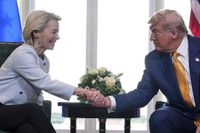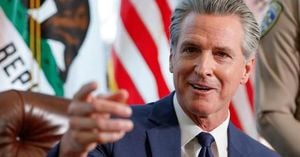On August 18, 2025, the White House became the focal point of urgent diplomatic efforts as Ukrainian President Volodymyr Zelensky, NATO Secretary General Mark Rutte, and a host of leading European figures gathered with U.S. President Donald Trump. Their mission: to find a path toward ending the grinding war in Ukraine, while wrestling with the broader implications of Trump’s hard-edged foreign policy—a style that has left allies and adversaries alike scrambling to keep up.
Just weeks earlier, on July 27, Presidents Ursula von der Leyen of the European Commission and Donald Trump had signed a trade agreement that seemed, at least on paper, to cap U.S. tariffs on European Union goods at 15%. Pharmaceuticals, a major European export, were explicitly included. The ink was barely dry when, on August 5, Trump shocked European capitals by threatening to hike pharmaceutical tariffs to a staggering 250%—a move that openly violated the new agreement and sent ripples of anxiety through transatlantic markets.
According to Shamsoddin Shariati, as cited in the Financial Times, this was no accident or diplomatic blunder. Instead, it was yet another example of what he described as the “predictable Trump playbook.” The pattern, he argued, is clear: set ultimatums, escalate threats, and then negotiate under pressure, always with the goal of extracting maximum concessions. “Trump seeks not agreement, but surrender,” Shariati wrote, warning that Europe must now learn to stand firm rather than concede ground in the face of such tactics.
The recent tariff drama is hardly an isolated incident. The seeds were sown back in April, when Trump announced an initial 25% tariff on European imports, only to pause implementation for three months. This pause, European negotiators quickly realized, was less a gesture of goodwill than an implicit ultimatum—an attempt to force the EU’s hand. By mid-July, as trade talks appeared to be making progress, Trump abruptly raised the stakes, announcing 30% tariffs effective in August. Under this mounting pressure, the EU reluctantly agreed to the 15% cap, only to see that agreement nearly torn up days later.
This brinkmanship has played out on other fronts as well. The ongoing conflict with Iran offers a telling parallel. In June, as U.S.-Iran nuclear negotiations limped along, Trump issued a 60-day ultimatum for Iran to dismantle its nuclear facilities. On the 61st day, war erupted, with Israel launching a military offensive and the U.S. joining the fight nine days later. The result? U.S. bombing delayed Iran’s nuclear progress by only a few months, while Iran ceased cooperation with the UN’s nuclear watchdog and began preparing to withdraw from the Non-Proliferation Treaty. The cost, both strategic and economic, was high, and the hoped-for “big win” proved elusive.
Shariati pointedly observed, “Trump’s objective was never a reciprocal deal during the 60-day negotiations. Instead, he sought Iran’s complete surrender to his illegal demands to dismantle their nuclear facilities.” The comparison with the EU is hard to miss: in both cases, Trump’s approach has been to present extreme demands, threaten dire consequences, and then trumpet any concession as a personal triumph.
Russia, too, has become a proving ground for Trump’s tactics—albeit with mixed results. Over the past six months, Russian President Vladimir Putin has repeatedly used Trump’s own playbook against him, launching attacks on Kyiv during peace talks and exploiting moments when Trump believed he had secured a deal. In March 2025, U.S. actions led to the return of the Kursk region, previously held by Ukraine, to Russian control. Undeterred, Trump issued a 50-day ultimatum for a peace agreement, threatening secondary tariffs if Russia failed to comply. Predictably, Putin responded with renewed military action and thinly veiled nuclear threats.
At the heart of Trump’s international strategy lies a zero-sum worldview. As outlined in his bestselling book The Art of the Deal, Trump sees negotiation as a form of warfare: “The objective is not mutual satisfaction, but to extract maximum value from the other party, to their detriment.” Tactics such as artificial deadlines, psychological pressure, and public boasts of “big wins” are all part of the arsenal. For Trump, every agreement is a contest in which someone must lose for another to win.
This uncompromising approach has left Europe facing stark choices. Some, like former European Commission trade chief Jean-Luc Demarty, have called for a tougher stance: “Europe must put its gun on the table for the tariff negotiation with Trump.” The argument goes that further concessions will only embolden the White House, risking ever more severe economic penalties. Conversely, standing firm—though costly in the short term—could ultimately weaken Trump’s domestic support if American consumers begin to feel the pinch of higher prices ahead of the 2026 midterm elections.
Meanwhile, the NATO alliance itself has not been immune to the tremors of Trump’s diplomacy. At the June 2025 NATO Summit, the alliance’s now 32 members reaffirmed their “ironclad commitment to collective defence” under Article 5, the bedrock principle that an attack on one is an attack on all. This came after months of pressure from Trump, who had previously questioned the mutual guarantee but, following the summit, declared, “I stand with [Article Five], that’s why I’m here.”
NATO, founded in 1949 to counter Soviet expansion, has long relied on the shared commitment of its members. Yet the alliance’s future has become a subject of debate, especially as Trump has pressed European countries to increase defense spending. After the summit, members agreed to boost core defense expenditure to 3.5% of GDP by 2035, with an additional 1.5% for broader security infrastructure—a significant jump from the previous 2% target. Some, like Spain, Belgium, and Slovakia, expressed concerns but ultimately accepted the new requirements.
Ukraine’s own bid for NATO membership remains unresolved, with Russia’s vehement opposition and ongoing conflict standing in the way. While Zelensky has pushed for fast-tracked entry, U.S. Defense Secretary Pete Hegseth stated in February 2025 that “the US does not believe that NATO membership for Ukraine is a realistic outcome of a negotiated settlement.” Still, Zelensky has shown a willingness to make personal sacrifices, telling reporters, “If to achieve peace you really need me to give up my post, I’m ready. I can trade it for NATO membership.”
As the war drags on, Western support has remained vital. According to the Kiel Institute, the U.S. has provided over €64.6 billion in military aid to Ukraine since February 2022, while EU states and partners have contributed nearly €80 billion. The form and scope of the “security guarantees” discussed at the White House remain unclear, but the stakes for Ukraine—and for the credibility of Western alliances—could hardly be higher.
With Trump’s confrontational style once again shaping the global order, Europe, Ukraine, and NATO face a defining moment. Whether by standing firm or seeking new compromises, their response will set the tone for transatlantic relations—and the future of peace and security in Europe—for years to come.





